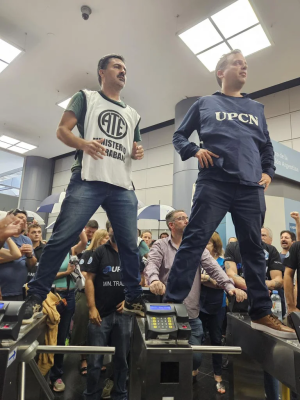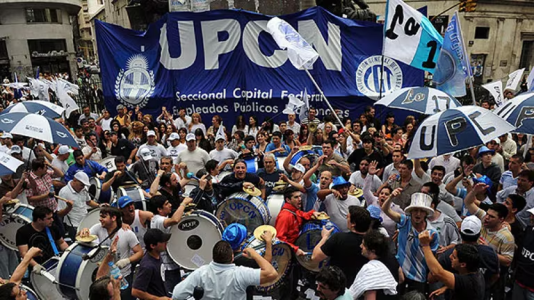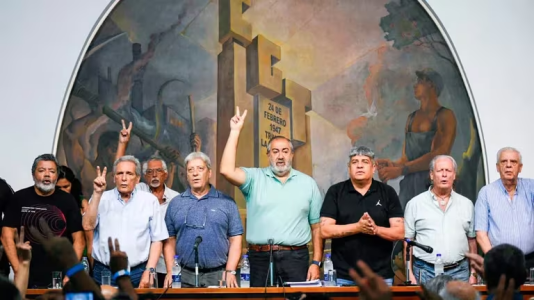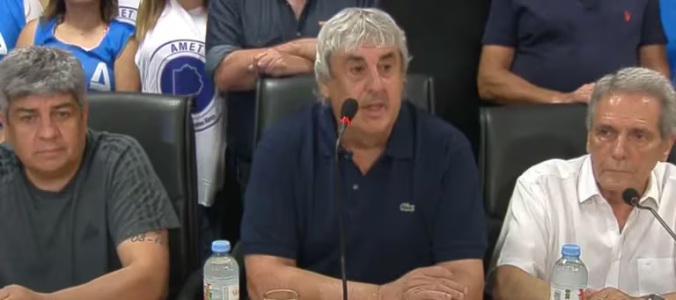All the Answers
Well-known member
Key day for the union offensive against the Government: the CGT deliberates today on a new strike and the state workers protest - Infobae

Source:

Día clave para la ofensiva sindical contra el Gobierno: la CGT delibera hoy sobre un nuevo paro y protestan los estatales
La mesa chica cegetista retomará su debate interno, aunque no le podrá fecha a otra medida de fuerza. La Asociación de Trabajadores del Estado (ATE) hará marchas, asambleas y “tomas pacíficas” de edificios públicos en contra de 11.000 despidos en el sector
April 03, 2024
The small Cegetista table will resume its internal debate, although it will not be able to date another measure of force. The Association of State Workers (ATE) will hold marches, assemblies and “peaceful takeovers” of public buildings against 11,000 layoffs in the sector
By Ricardo Carpena

The head of ATE, Rodolfo Aguiar: "If there is violence and repression, the only person responsible will be the Casa Rosada"
Unionism will have a key Wednesday in its offensive against the government of Javier Milei. The Association of State Workers (ATE) will hold various protests in the morning against layoffs in the public sector, which will include the “peaceful occupation” of state offices , and in the afternoon it will define a strike with mobilization that would take place this week. And, after a two-month hiatus, the CGT small table will meet again in the afternoon to debate the socioeconomic situation and continue agreeing on the date and modality of a new force measure.
In the case of ATE, its owner, Rodolfo Aguiar , warned Infobae that, “from 9 a.m., in all ministries there will be a massive presence of workers to take their places and make it clear that it is the Government that acts at the same time. margin of the law", although he stressed that the leadership of the union will be present in front of the Ministry of Labor, at Leandro N. Alem 650, because the most massive concentration will take place there, since "it is one of the places with the largest number of laid off , 523 out of a total of 11,000 that were registered throughout the country.
“We are going to hold an assembly outside the Ministry of Labor and two things can happen,” the union leader anticipated. That the building is blocked and fenced, with security inside, or that there is no such operation, with which massive entry will be made and the workplaces will be occupied.”

Delegates from ATE and UPCN joined in the claim against layoffs at the Ministry of Labor
Although the ruling party assured that these are not layoffs but rather non-renewal of contracts that expired on March 31, Aguiar rejected that argument: “It is a bigger euphemism than the Casa Rosada,” he stated. With this the Government tries to strengthen a falsehood of proportions. The officials are businessmen or company managers who believe that in the State they can apply the same standards to workers as in the private sector, but in public employment there is stability.”
According to the ATE leader, “the Government set up a true apparatus of lies because some put the emphasis on the number of dismissals and that prevents us from talking about how each dismissal is an individual tragedy for the worker and his family, but, furthermore, “a collective tragedy because behind each position there is a public policy that is being dismantled and many services that the State will restrict.”
The other union in the sector, the Union of Civil Personnel of the Nation (UPCN), chose a different strategy to protest against the adjustment and layoffs in the State: it carried out specific protests in the agencies affected by the cuts, such as the ANSES and the ministries of Labor and Health, among others, with assemblies and batucadas to express their demands. And sources from the union led by Andrés Rodríguez anticipated that they could carry out strikes of 2 or 4 hours, although a 24-hour strike is not planned at the moment, much less the occupation of buildings, like ATE.

UPCN protests against the adjustment in the State with a different strategy from that applied by ATE, the other public sector union
Regarding the difference in strategies between the two state unions, Aguiar downplayed the different ways of protesting: “These are not times for fissures to begin to emerge in the labor movement. It can respond to different strategies, although from ATE we are going to exhaust all avenues to call for the broadest unity and a unity of action with UPCN that allows us to more effectively defend the rights attacked in the public administration."
The head of ATE also referred to the CGT's delay in defining another general strike: "If the CGT finds it difficult to set a date for a strike, let the two CTA do it and let's take to the streets because there is a need to unify all the claims -he maintained-. We state officials are not the only ones who are having a hard time. Retirees are going to be paid in installments, businesses are closing, small and medium-sized businesses have many problems. We are part of the autonomous CTA and we already proposed that we had to move towards a general strike of the three workers' confederations."
In any case, the CGT will return to activity this afternoon: after the last meeting it held in mid-February, the CGT small table will deliberate “without an agenda” at the UPCN headquarters, at Moreno 1332, to “analyze, coordinate and follow consensual”, as one of its members anticipated to Infobae. This means that today a date will not be set for a new measure of force (the second after the 12-hour strike with mobilization on January 24), but that the socioeconomic situation and the pressures from various union sectors to accelerate will be evaluated. another protest.

The small table of the CGT will resume its debate today on how to continue the plan to fight against the Government
In itself, the co-head of the CGT Pablo Moyano (Truck Drivers), Sergio Sasia (Railway Union) and Juan Carlos Schmid (Dredging and Beaconing), who lead the Argentine Confederation of Transport Workers (CATT), whose The national plenary decided last week to “accompany the CGT agenda” and decided to hold “simultaneous scheduled assemblies in the work sectors” in April, which is a way of carrying out a covert strike.
When speaking before some 400 leaders of railway, aeronautical, truck, maritime and taxi drivers, the deputy secretary of the CATT, Schmid (Dredging and Beaconing), admitted that there will be assemblies “from 7 to 10, interrupting services” as a “first step to go towards measures of greater intensity.” And he pointed out: “We have to win the fight with intelligence. “We are not going to do anything with a single strike.”
In the same way, three leaders who joined together last week to demand a plenary session of general secretaries of the CGT in order to decide another strike: these are Luis Barrionuevo (gastronomic) and Omar Maturano (La Fraternidad) and the co-owner of the CGT Carlos Acuña (service stations). The author of the famous phrase “in Argentina no one makes money working” even asked that Héctor Daer, the Cegetista co-owner and champion of the dialogue sector, declare a strike and resign from his position, as Gerardo Martínez did, as he recalled without any innocence. (UOCRA), another exponent of the moderate wing, when he was general secretary of the CGT during the government of Carlos Menem.

Sergio Romero, along with the co-heads of the CGT Pablo Moyano and Carlos Acuña: UDA will be one of the teaching unions that does not accompany the strike ordered by CTERA for this Thursday
Another union that did not wait for the CGT or the two CTAs to launch a forceful measure is the Confederation of Education Workers (CTERA), which last night called for a national teaching strike for next Thursday, April 4, to demand joint participation. salary of the sector and the restitution of the National Teacher Incentive Fund (FONID) that the libertarian administration eliminated.
However, the teaching unions that make up the CGT, led by the Argentine Teachers Union (UDA), whose head is Sergio Romero, Secretary of Educational Policies of the workers' union, will not accompany the protest decided by CTERA although they had been talking for weeks about the possibility of carrying out a joint measure against the Government.
“We share CTERA's reasons for going on strike, but we believe that it is not appropriate to go on strike after so many days without class,” admitted a leader who is a member of the CGT. Here too, as happens in the state unions, the unrest against Milei's policies is the same, although there are strong differences regarding the strategy and times to carry out the protests.

